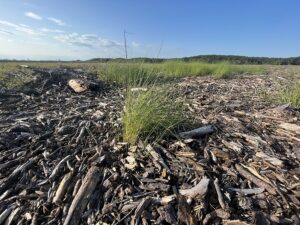WELLFLEET — As you drive down Griffins Island Road toward Duck Harbor, your eyes are drawn to what looks at first like a treeless wasteland.

On closer inspection, you notice masses of green vegetation sprouting. “That’s all pioneering saltmarsh species,” says Geoff Sanders, chief of natural resource management and science at the Cape Cod National Seashore. Glasswort, saltmarsh spikegrass, salt hay, and sea blite are among the plants making a comeback, he says.
The freshwater vegetation that had colonized the Duck Harbor basin after the Herring River was diked in 1909 was almost entirely wiped out when salt water rushed in during storm tide overwashes in 2020 and 2021.
After the removal of 80 acres of that dead vegetation this past winter, the saltwater plants restoration experts had hoped would flourish here have made an impressive rebound. With regular saltwater flooding, the western portion of Duck Harbor should revert to salt-marsh grasses, says John Portnoy, co-chair of the science advisory group at Friends of Herring River. The eastern portion is expected to receive less water until the later stages of the Herring River Restoration Project.
Dale Rheault, chair of Friends of Herring River, says that although the removal of vegetation at Duck Harbor will enhance the work of the Herring River Restoration Project, the timing is just a coincidence.
For scientists working on the restoration, the Duck Harbor recolonization has provided an opportunity for experiments with transplantation and seeding. Sanders says that Park ecologists have transplanted plugs of saltmarsh cordgrass without great success, so now they tentatively plan to reseed the Duck Harbor basin after 40 more acres of vegetation are removed in November.
Since the groundbreaking ceremony on March 1, the restoration timeline has held steady, according to Sanders. In March, two houses on Way 672 in Wellfleet that the Seashore acquired in 2017 and 2019 to facilitate the restoration were taken down due to concerns about their vulnerability in the face of tidal flow.
The MIG Corp. of Acton, the contractor hired by the town of Wellfleet, is expected to complete a temporary bypass bridge next to the dike by October. Once the bypass bridge, a single lane with a signal on either end, is done, people will be able to access Griffin Island, Duck Harbor, and Great Island while work on a larger bridge takes place.
Jacqualyn Fouse, who lives in the last house on the right as you near the dike, says she has not been affected by the construction. “I think they are doing a really great job not being very disruptive to everything out here,” she says. Fouse is the treasurer for Friends of Herring River.
In this first phase of the project to restore tidal flow in the river, low-lying roads will be raised, culverts will be replaced, a few freshwater wells will be relocated, and the Chequessett Club golf course will be elevated.
The Park Service is also planning the removal of soil berms that were created when the river was channelized decades ago, but the timeframe for that work hasn’t been determined.
Once the larger bridge is completed, 165 feet of tidal sluice gates will be opened a bit to increase tidal flow in the system. Using adaptive management techniques, scientists will begin by letting in small amounts of water. That’s when, Sanders says, “you will start to see changes in vegetation. You will start to see improved fish passage.”
Currently, the marsh edge is artificially about a meter below sea level because of the diking; the sediment has subsided due to limited tidal flow. With the restoration of the flow, sediment will move into the area and rebuild the marsh.
At that point, Rheault says, the sluice gates “will not be opened any further for at least two years.” That way, “scientists can monitor how tidal flow impacts the estuary.”
Ronald Gabel, a Yarmouth resident who is among those who have been critical of the project, says he remains wary of it. Gabel and others say the project may have significant unintended consequences that Wellfleet taxpayers could be held liable for.
Sanders believes that “there really is a preponderance of evidence that the restoration is going to be a huge benefit, and it’s not going to result in a lot of these issues people are worried about.”
Portnoy agrees, adding that “the Herring River Project will protect upland shoreline development around the marsh edge.” As saltwater grasses recolonize, he says, they impose significant friction on water flow, which should help protect against the higher storm surges that are likely to be increasingly frequent with rising sea levels.
“A lot of work, science, research, and monitoring has gone into preparing for this,” says Sanders. “If, by some chance, something unexpected happens, you can always manage the water level with the tide gates.”
